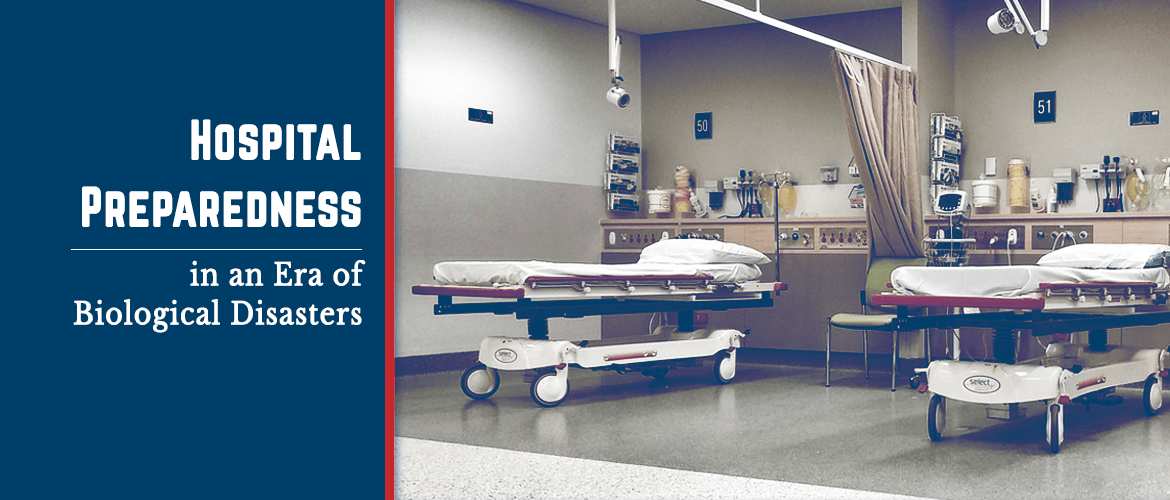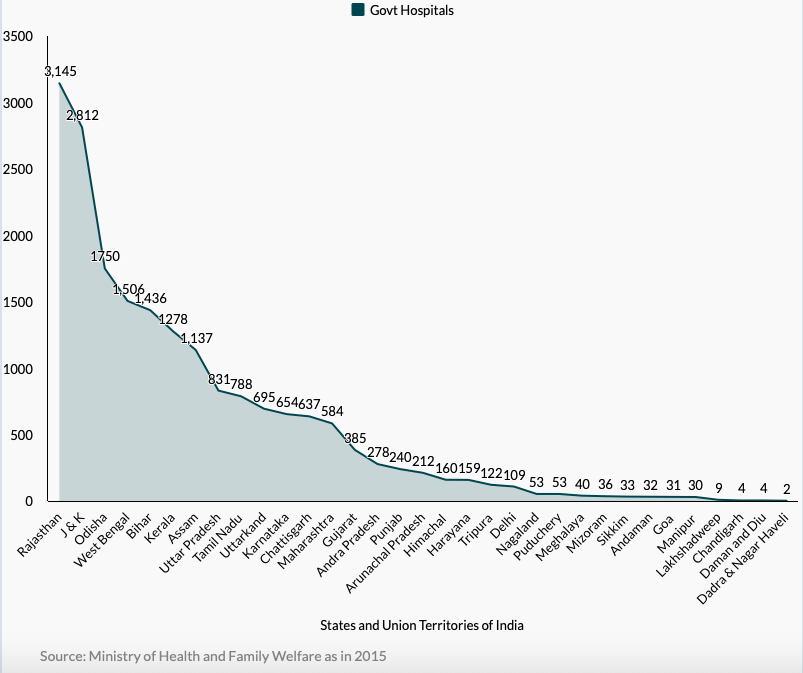Hospital Preparedness in an Era of Biological Disasters
April 23, 2020 | Expert Insights

Hospitals are sanctuaries of healing that play a decisive role in the outcome of a pandemic. For an exotic contagion like SARS CoV-2 causing COVID-19, much more preparedness and a deeper understanding of the disease dynamics is required. Orchestrating a national and global response greatly lies within the network of hospitals. Nothing can prepare us for a biological disaster if we do not forecast it. Hospital preparedness is not an extravagant measure to mitigate an imaginary threat, but a hard reality brought to attention by this biological disaster.
Resource Limitations & Surge Capacity
Pandemics can exhaust the finite resources of any country. Further, an unprepared hospital will be unable to meet the sudden surge in cases. During an outbreak, this trend is expected to escalate until the hospital collapses under the duress. Inability to meet the demand-supply of Personal Protective Equipment (PPE) shows the lack of alternative manufacturing options. Though the improvisation of existing raw materials for PPEs appears innovative, it might fall short of the required standards.
The exponential demand for respiratory assist devices like ventilators and a diminishing stockpile of essential oxygen can have devastating consequences. Pre-designated isolation venues and decontamination sites are not routinely incorporated into any hospital facility design. Further, shutting down of hospitals as contaminated sites even temporarily deprives the delivery of routine health services.

Health Care Worker Fatigue & System Failure
Every health care worker has multiple facets of personality, which might not be readily visible. 'Prevention fatigue' can set in due to long hours of work in an overloaded system. The doctor or nurse could lower their guard resulting in an exposure. The second aspect is the ‘bystander effect’. When health care workers observe illness and fatalities among their infected cohorts, it can lead to mental exhaustion and poor clinical judgment. This, in turn, can have an en-masse effect.
Assessment
Hospital Biosafety & Hospital Infection Control – inclusion of hospital biosafety as a standard feature in every hospital infection control program. Assigning a biosafety officer and creating written standard operation protocols.
Hospital Design & Construction- from now on any new health facility has to take into consideration the possibility of treating pandemics. All the above-mentioned clauses should be incorporated into the design. While previously built structures may be remodelled.
Hospital Ergonomics & Rostering- hospital workforce should not be overburdened; the duties should be cycled rightly. Plus facility enhancement to address workforce comfort and fatigue prevention should be considered. Mental health issues should be addressed.
Hospital Stockpile, Biological & Antidotes- pharmacies can store an added stockpile of experimental drugs, antidotes and monoclonal antibodies. Many repurposed drugs can be given as ‘first-use’ in an outbreak due to a previously unknown pathogen.
Hospital Expansion & Annexation- to address the surge of patients, neighbouring sites and large storage areas should be identified. A written memorandum to use such spaces during biological emergencies should be in place.
Hospital Early Warning System- disease forecasting and early warning virtual applications could be integrated into hospital management systems. It will provide time for pre-emptive action.
Hospital Epidemiology & Disease Surveillance – infection control teams and intra-hospital and inter-hospital disease surveillance can help in identifying the sudden appearance of disease clusters (like- atypical SARS like pneumonia in Wuhan).
Hospital Training & Mock Drills- even a basic program of routine training and frequent mock drills provide a reasonable deterrent against any unknown pathogen. Simulants and surrogates can be used to train hospital staff.
Hospital Decontamination & Disinfection- decontamination and disinfection of hospital sites pose a serious challenge. Based on the characteristics of the pathogen, plans for various forms of decontamination with approved biocides and surface disinfectants should be in place.
Hospital Laboratory Network- a chain of allied hospital microbiology laboratories can act as a sentinel in the time of the outbreak and can greatly aid in early identification and drug sensitivity panels. Apart from that, forensic microbiology could be used to identify genetically modified organisms.
Conclusion
COVID-19 has changed the landscape of hospital practice; we need to adopt a fluid and creative approach to bio-preparedness. While we scramble to contain this pandemic, the next one is likely in the making. It is only a matter of time before it emerges. In the canopies of tropical rainforests, amidst deep wood jungles, among the wet markets trading exotic animals and in a hunter’s bush meat, an unknown pathogen is evolving. It could have recombinant properties and is likely to be refractory to current approaches. It is time we prepare for it.
References
Popescu, S. Hospital biopreparedness in the Looming Presence of SARS‐CoV‐2/COVID‐19. Health Sci Rep. 2020; 3:e149.
Chung S, Shannon M Hospital planning for acts of terrorism and other public health emergencies involving children Archives of Disease in Childhood 2005;90:1300-1307.
Author : Gifty Immanuel, MD, PhD, MPH, FFPH








Submitted by Mercy Suja (not verified) on Fri, 04/24/2020 - 13:18
Your writing inspires me.
Your writing inspires me. Wholistic write up. Looking forward to read these type of writes from you . Thank you
Submitted by FLORA NELSON (not verified) on Fri, 04/24/2020 - 17:30
Excellent Insights Gifty on
Excellent Insights Gifty on Bio Preparedness
Submitted by Prof. S. Shanmugavel (not verified) on Fri, 04/24/2020 - 17:47
Well researched article
Well researched article
Submitted by S. SHANMUGAVEL (not verified) on Fri, 04/24/2020 - 17:58
Well researched article
Well researched article reflecting deep knowledge on hospital management
Submitted by Chandra Paulin… (not verified) on Sat, 04/25/2020 - 19:11
An excellent article which
An excellent article which encapsulates hospital-preparedness for a biological disaster. Thank you!
Chandra Pauline Daniel Ph.D.,
DrPH: Health Policy and Management,
New York Medical College.
Submitted by Chandra Paulin… (not verified) on Tue, 04/28/2020 - 03:45
Excellent article that
Excellent article that encapsulates the significance of preparedness for a biological disaster such as the COVID-19. Thank you for sharing this article. It will cited in the project at the New York Medical College.
Chandra Pauline Dinakar Daniel Ph.D, DrPH